
‘Craig Baldwin considers his work “underground” rather than “experimental” or “avant-garde”. Whereas the avant-garde is primarily concerned with formal exercise, and “experimental” implies some experiment (i.e. that something new is being tried for the purpose of determining whether of not it can expand the limits of cinematic language), “underground” would encompass not only formal plasticity but a political dimension; that of an oppositional subculture.
‘As such, Craig Baldwin’s films have formal concerns as well as some kind of political commentary, usually concerning the exploitation of countries and people under imperialism, capitalist or otherwise. Even when he is inventing the oppression (as in the alien presence of Tribulation 99 [1991]) it is either a metaphor for a real-world situation or it is combined with verifiable history. The aliens of Tribulation 99 may come from the destroyed planet Quetzalcoatl, for example, but they are apparently working with Kissinger to subject local populations in Central America. The science fiction and the fact are intertwined.
‘Baldwin’s work is most easily characterised by his use of recontextualised film elements, primarily drawn from his vast library of what Rick Prelinger, his fellow archivist and collector, calls “ephemeral films” – educational and industrial films chiefly made in the period between 1945 and 1975. These, along with a healthy dose of science fiction and period dramas, make the pool from which Baldwin draws. As libraries and schools began to renovate their A/V departments in the 1980s and 1990s, an avalanche of outdated materials became available, and the creative possibilities seemed obvious to the young director.
‘Craig Baldwin was born in Oakland, California, in 1952. He began making Super-8 movies when he was a teenager – the kind of skit-oriented parody films involving friends and neighbours. He was drawn into the practice of collage rather naively; he was interested in cheap and readily available Super-8 dubs of Hollywood B-movies that were for sale in the ’60s and ’70s. From these he would assemble compilations, mixing and matching scenes from various productions to create new stories. He made them for his own enjoyment, but it became the basis for his process in subsequent years.
‘Later, Baldwin attended several universities, dabbling in various disciplines (notably theatre), but always somehow gravitating towards film. These schools included U.C. Davis, U.C. Santa Barbara, and finally San Francisco State. At SFSU Baldwin was fortunate enough to take studio classes with film collage master Bruce Conner, who was teaching there at the time.’ — Tim Maloney
___
Stills
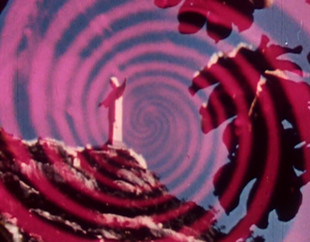


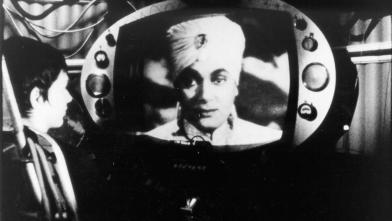









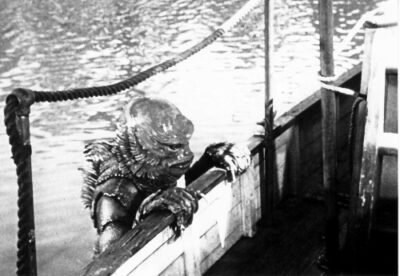












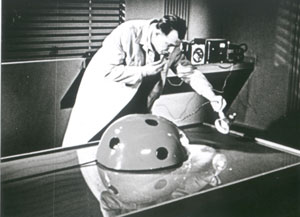




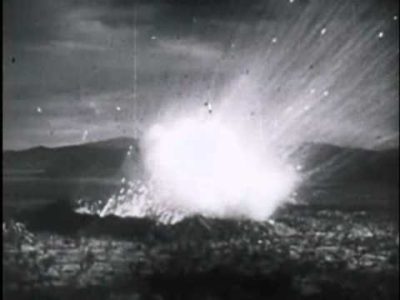

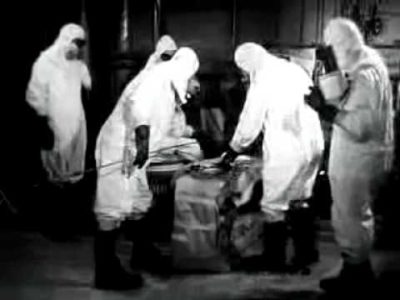
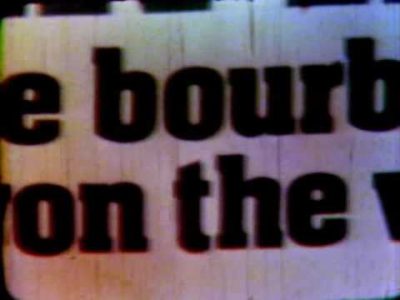

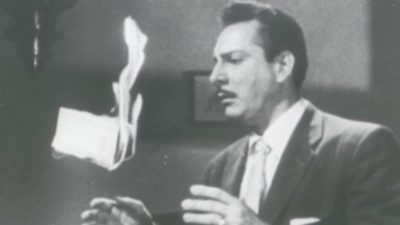

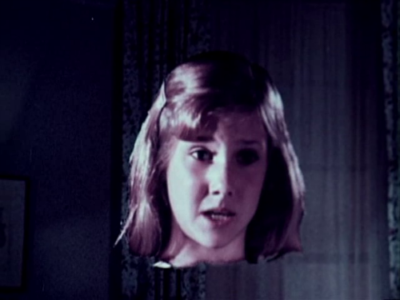

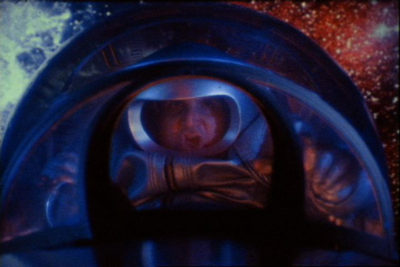

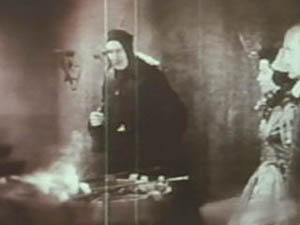




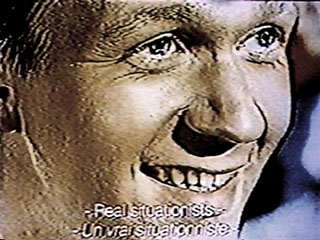

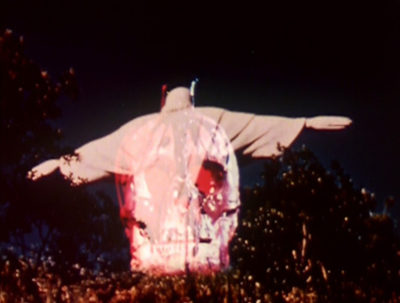



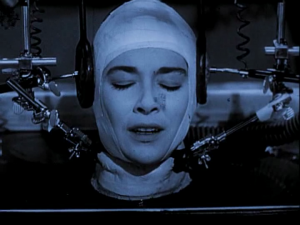
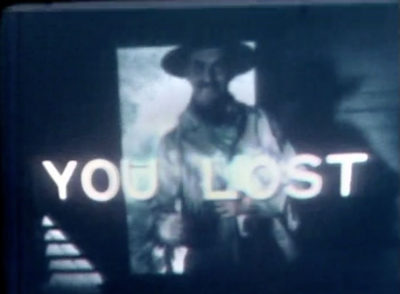
____
Further
Craig Baldwin @ IMDb
Craig Baldwin’s films @ Other Cinema
Craig Baldwin • Great Director profile • Senses of Cinema
Craig Baldwin’s films @ Fandor
Masochism of the Margins: An Interview with Craig Baldwin
Essential SF Q&A: Craig Baldwin
Craig Baldwin: Experimental Filmmaker
Leftovers / CA Redemption Value: Craig Baldwin’s Found-Footage Films
Puzzling and complex Craig Baldwin
Game Art: Craig Baldwin’s Wild Gunman
Found Footage Film as Discursive Metahistory: Craig Baldwin’s Tribulation 99
Craig Baldwin: Archive Fever
Going Ballistic: Craig Baldwin’s Mock Up on Mu
Star Log: Trippy Sci-Fi Mash-Up Alert!
No Copyright? Sonic Outlaws Director Craig Baldwin
podcast #10: Craig Baldwin
Film Coctail
_____
Extras
Craig Baldwin: Society of Spectacle
Craig Baldwin – Appropriating, Scratching and Decoding
Channel Zero: Craig Baldwin
In the Library of Particular Significance with Craig Baldwin
__________
Avant to Live!

Nearly five years in the making and clocking in at 508 pages, Craig Baldwin: Avant to Live! documents the life and work of acclaimed filmmaker and curator Craig Baldwin (b. Oakland CA, 1952), an inspiring and influential figure in contemporary media arts. Meticulously detailed, with contributions from over 50 writers, artists, illustrators and ideologues, AVANT TO LIVE! is the first critical text to examine the artist’s films analytically as a coherent and meaningful body of work and critical artist’s statement while also examining the cultural impact of Baldwin’s Other Cinema curatorial project.
‘For nearly 50 years, the Bay Area filmmaker and curator Craig Baldwin has been an inspiring figure in contemporary media arts. His acerbic, densely-packed found footage films have traveled the globe, encouraging scores of nascent collage-essayists, culture jammers, and mockumentarians to action. A welcoming presence and steadfast fixture of San Francisco’s Mission District, Baldwin has been holding it down at 992 Valencia Street for decades, in defiance of sweeping gentrification, presenting his Other Cinema microcinema screenings in its street-level storefront theater while maintaining his legendary film archive/hoarder cave/work studio in the building’s basement. Ever seeking to revise and hybridize existing modes and genres, and invent and name new ones, Baldwin’s filmmaking amalgamates cinephilic literacy and voraciousness, a sharp understanding of political and cultural history, and a sly critical polemics. His films are further energized by an encyclopedic knowledge of his own sprawling collection of cast-off educational films and B-grade features and a perverse proclivity for sourcing surreally sublime moments from industrial film effluvia. Informed by left politics, cult cinemas, agit-prop activism, structural film, the Situationists, the Yippies, Arte Povera, media archeology, compilation documentary, and other found footage forms, Baldwin’s praxis is bound by a dual commitment to materiality and aesthetics on the one hand, and disruptive action and fervent, antagonal rhetoric on the other; all the while articulating a contrarian (and at times utopian) sense of apocalyptic historiography.’ — Brett Kashmere & Steve Polta

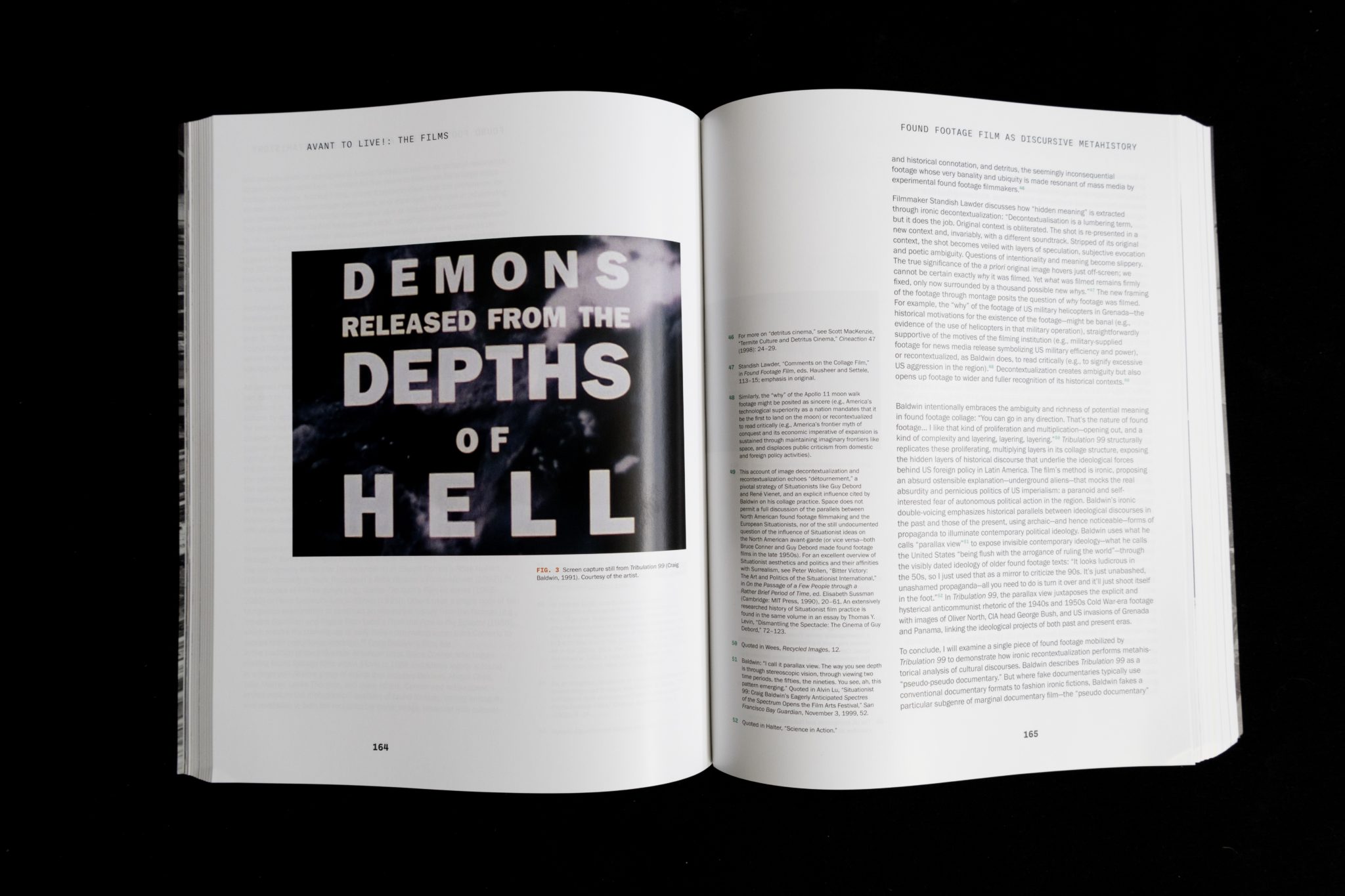
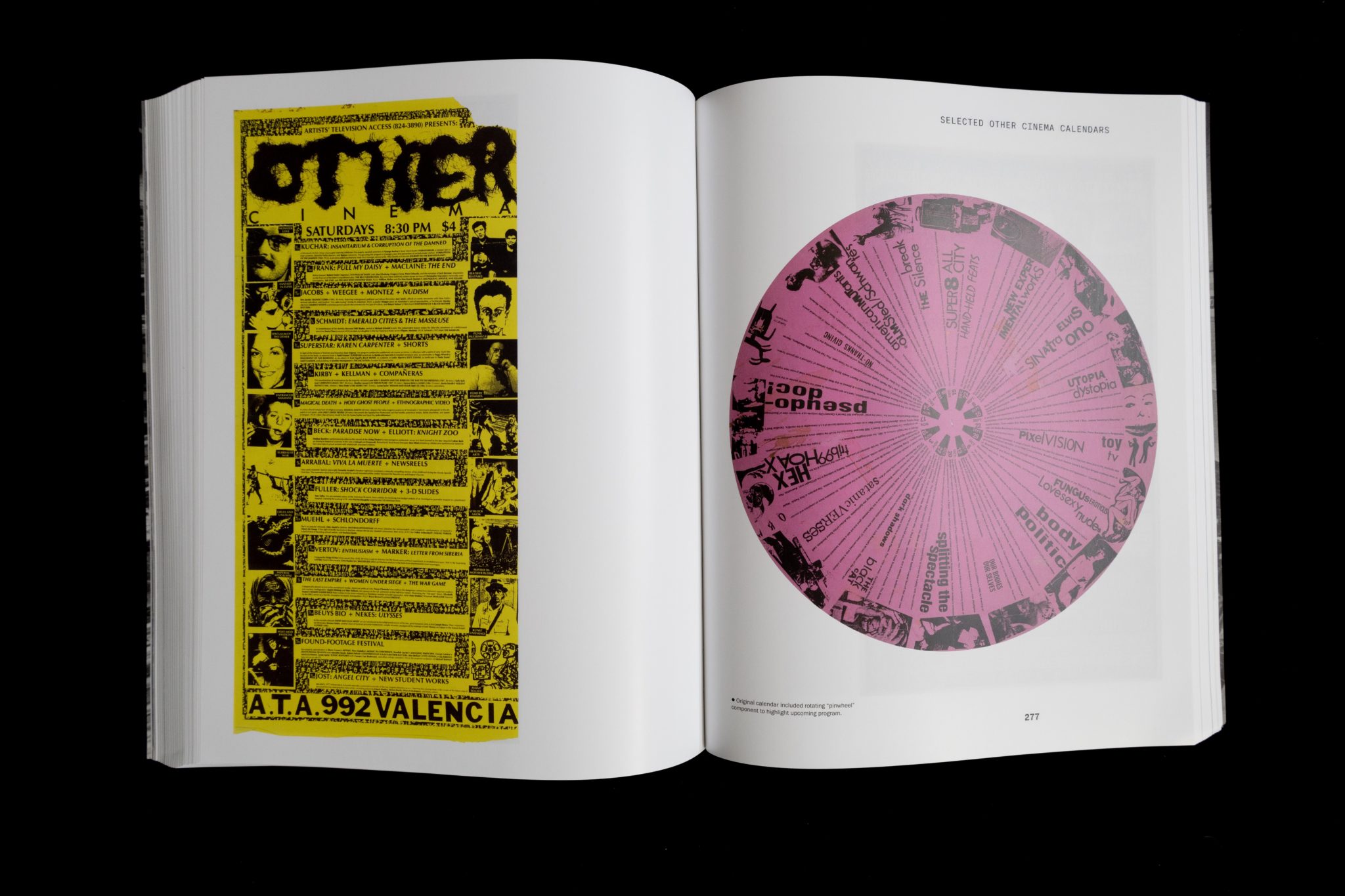
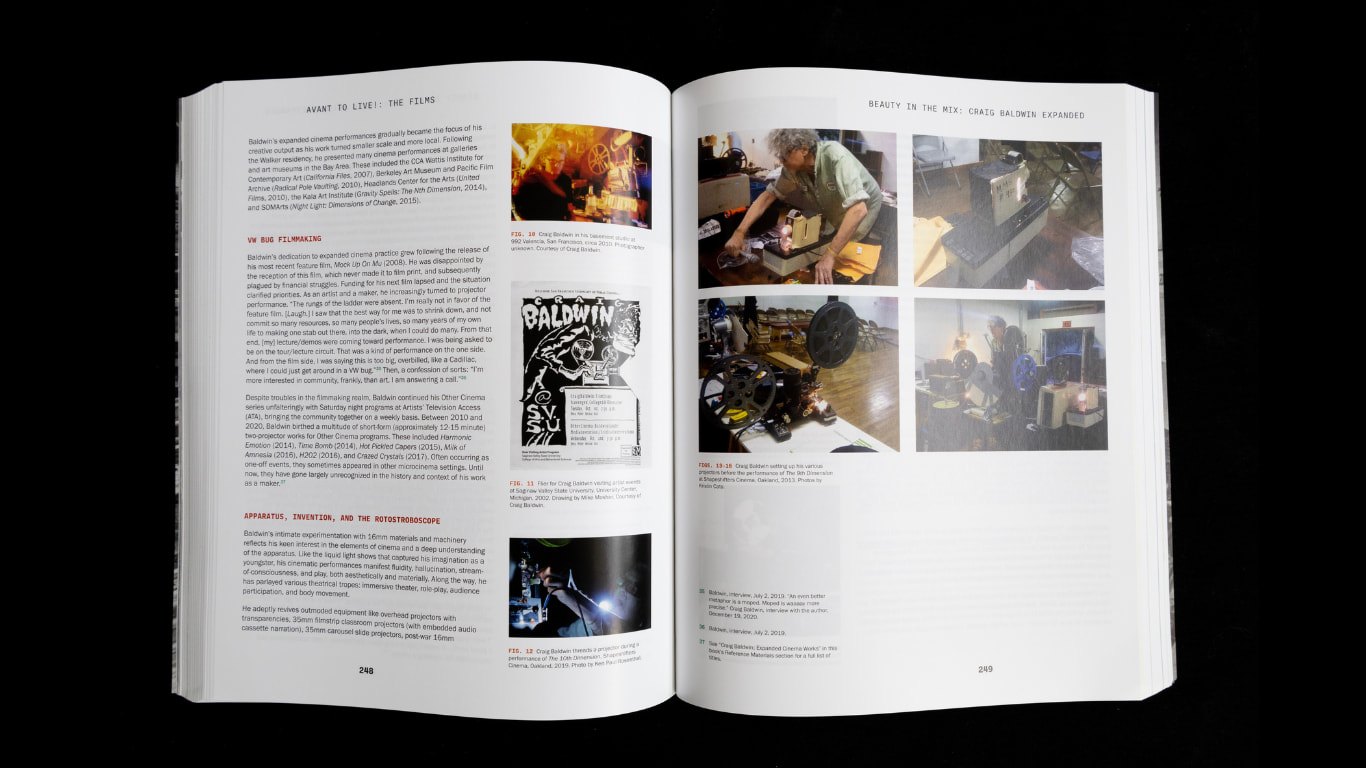
Craig Baldwin: Avant To Live!
_____
Interview
from Senses of Cinema

Jack Sargeant: I want to begin by asking about your education background, because you studied with Bruce Conner.
Craig Baldwin: Sure. He was teaching at State, which was a public school, but he lives about three miles away anyway. He’s not a recluse, you come across him, and certainly his influence is all across San Francisco. But it is the sort of scene where you do have a relative amount of access.
JS: But you were familiar with his work previous to going to college?
CB: Oh yeah. Sure. But you know, Bruce Conner used to do light shows, that’s kind of how I got into filmmaking myself. That’s my whole approach, not from an academic point of view, or even from a documentary point of view, it’s more from a sub-cultural impulse – the clubs, rock and roll, youth subculture and creating this idea of kind of a ‘happening’.
JS: You worked in clubs all over San Francisco?
CB: A lot of clubs. Most of the South of Market clubs [i.e. downtown]. [Using] Five or six projectors… it’s not so much that you have to get access to this very rarefied, distanced, fine arts, it’s more like being part of a whole culture where people are very playful and sharing in the idea of creating an event. That’s more my relationship to Conner, it’s not so much tutor and mentor, it’s more like being immersed in this – not exactly psychadelia – but this whole environment of visual play, visual experimentation.
JS: With his films like A Movie, Conner was part of a particular analysis of the media by people such as Marshall McLuen, the whole idea of a visual reservoir.
CB: Well I don’t know if McLuen ever saw his stuff but ideas were in the air…
JS: The Zietgeist.
CB: Right. Again, sort of being able to literally enact this image culture that we are in anyway, but actually project it back on itself, with the agency of the imagination to be creative about it, not just be recipients but also happily celebrate it, be participants in it, this joyful, wallowing in excess, and maximizing it.
JS: What was the first film that you made?
CB: Well, there were no names for them…
JS: Just experimental…?
CB: They were just playing around with Super 8, stuff like that. The first one I made in a formalized way was – I made three or four when I was basically eighteen or so, Super 8 films – Why Not? .
JS: What kind of things was going on in them?
CB: A mixture of gestures, it wasn’t sync, it wasn’t dialogue based, gestures in front of the camera, plus extraneous material, collateral material, shots of this or that. Actually, I do remember being a subscriber to these Super 8 movie clubs, and I would get their reels, like movies from the silent era, old news reels, things like that. I took great delight looking through this old material. So even very early on, I used to [make] little home compilations, cutting up these little pieces, and then mixing them together. It’s definitely what you would call experimental film.
JS: What year was this?
CB: About 1974.
JS: I’m really interested in the fact that you could buy so much footage so cheaply…
CB: Oh, you can do it now. You’ve got a huge, huge subculture right now of Super 8, regular 8 even, and certainly 16mm. I am a subscriber to these zines, in fact there is a great journal you should check out called The Big Reel. You can subscribe – you wouldn’t want to – I mean I had to stop subscribing. You know the Sunday Paper with eight sections, maybe a total of 120 pages? The Big Reel looks like that. They actually made it more tabloid size now, but it used to be huge sections newsprint style, and I would just be pouring over them on my studio floor, from here [gestures down restaurant] to literally the front door. And I would just be tearing holes in the knees of my pants by moving while it was splayed out on the studio floor because I would be so obsessed with it.
So there was a period of time when I never considered myself this kind of fine art filmmaker or even a documentary filmmaker, because, for me, it’s more like a joy in the material, in the McLuenesque sense of being, the proliferation of meanings, gestures, and images, and this obsessive collector sensibility, not a rarefied minimalist, but a maximalist. The playful quality of film. Once you subscribe [to The Big Reel and collector culture in general] like I say I had to stop, because I was spending all my money on collecting these films and what I would do, I would cut them up, and that’s how I made these collage reels that became my lightshow. And even to this day I sell [to] other filmmakers who are working in the so called collage – or collage essay – tradition. They come to me and I would be able to give them a shot of the [Golden Gate] bridge from the air, which they can’t get for themselves obviously, it costs $200 to rent a helicopter to go up and shoot the bridge, but I can get it from a PanAm commercial. Or the Hinndenburg Zepplin going down, or whatever the case is, this kind of material and the vast archive of the collective unconscious of popular imagery, so I’ll have that. So that’s one of the ways in which I actually make my living, but also it satisfies me because I invest in that, again not because of fine art – or popular art either – just because of this play, this obsessive, fetishistic love, of images, being able to control them. In a casual, informal West Coast, funk way – funk is a good word – in the kind of tradition of Robert Nelson, or even Harry Smith to a degree…
Then I became a regular recipient of a list from a particular group of people, who send me their list every month to this day, that I correspond with and I call-up on the phone and buy. Like I say, this is part of a huge tradition, just like record collecting would be another example, going to the flea markets, of this underground subculture of people who are into having films and showing films, not because they want to go into business or into the industry as a job, but because they love it. The kind of films I ended up making were films which are filled with shots which I am attracted to, that I think are interesting or satisfying to look at. They give me some kind of visceral enjoyment. So this tradition of garage collecting or this exchange in the subcultural world – film geeks is what they’d be – people who fetishize the object of film. Not looking at what’s new or glossy, but looking at the rotting old bones…
JS: Also like old forgotten or neglected technologies, the most obvious being things such as 3D cameras, or eight-track tapes.
CB: Yes. So this idea of people with the flea market sensibility, or the do it yourself low budget, garage or junk aesthetic, so anyway this subculture I got into very early, you can go into camera stores and get little Super 8 digests of The Incredible Shrinking Man for example, or certainly porn. Most of it’s just junk, there are so many of them. That’s the whole American idea of this popular imagery, just pumping it out, just planned obsolescence. You can walk down the street and find records or eight tracks in the gutter. The same with Super 8 and 16mm, it’s kind of disposable material. So my whole project was to reclaim it, redeem it, this trash, which had been ruled obsolete, no longer of interest, and certainly of no value because there was new product coming along, shiny new.. this year’s model…that became increasingly more predictable, more banal, commercial, whatever, so I was increasingly drawn towards the…
JS: Detritus?
CB: The detritus. The blemished. Whatever. Anyway, I was always part of that.
My early films were experimental films like a lot of other young filmmaker’s films were. They were involved more with playing around with the camera. Very early on found footage found a way into the form of these Super 8 films, to try and tell something that was beyond the level of the real… mythic would be the word.. . slightly above the level of the real, they had more to do with larger ideas. Essays, collage essays as I call them, put a lot of different images together which have a certain kind of meaning which people know, there is a certain self-consciousness that certain shots mean certain things. Within the context, of course, of our received film history, and our popular culture.
But anyway, I made a film called Stolen Movie, in which I would break through the front doors, whatever would get you past the ticket office, of a theatre, and go and shoot Super 8 off the screen. This was certainly a transgressive gesture against corporate media, but was also an example of using found footage in a way – whatever footage happened to be on the screen (laughs) at the time I made it in. So it was like a chance operation: Dada, nonsense, provocative, Situationist, and also found footage. All those kind of things, that was more my project, not to make a beautiful film, but to make a critical gesture against the film industry, which was so firmly in place, and was based on such bad, retrograde narrative ideas and stereotypes.
JS: What drew you to Dada and Situationism?
CB: Well again, psychoanalytically I can not tell you why I’m drawn to it, it’s more of a response of my nervous system, it wasn’t because I studied Dada in school [that] I turned on to the ideas, it returns to my personal history. We were talking early about the whole whiff and the warp of American popular culture, and I was repulsed by it, and I found this need to separate myself from it and criticize it, so I had to get out of the suburbs. So although I actually went to university, I did drop out of school and travel around for many years before I returned to school. But the whole point was that I wanted to leave the middle class ideas that culture was accepted without question, was something that we conform to and find our identity in. I was someone who had a very critical, antagonistic attitude about popular culture, so Dada was in terms of art history a gesture that was opposed to a bourgeoisie culture and also high art. So I found spiritual resonance with the Dada, Situationists, punk, all those movements. Again to try and set up an agency for individual creativity outside of marriage, the family, commerce, and even Art. More of this idea of libertarian anarchism, or autonomy, which is the word I would use. So there was a rapport with the ideas not through academic rote learning, but just because that was my origins, the whole development of my personality, from the straight, white suburbs, I was a creature of that, a victim of that. There’s nothing extraordinary in that, it’s a story a lot of people will tell you. Part of the milieu in which I grew up – comfortable middle class; I’m not putting my parents down for that, but as soon as I had the opportunity to leave I did.
JS: You started collecting this stuff for rock shows and so on in the ’70s. At what point did you decide to start choosing pieces of film and constructing them as these mytho-narrative pieces?
CB: Good question. There wasn’t any one particular point. It was just… you could take any chunk of the collage I would make and there would be a certain kind of form to it. I have fifty reels. I’m not talking about ten or twenty, I have fifty, or sixty, or seventy reels that I put together. You know, some people watch football, or play cards or whatever, it’s just the kind of thing I would do, an expression of my lifestyle: look at material and hack it up, and reconfigure it. For me that’s fun, it’s satisfying, it’s creative too, by the way. Within each cluster, bundle, whatever you call it, little montage sequence, there is an aesthetic sensibility. It ain’t no big deal by the way, there’s a million of them out there, these little reels. But sooner or later they get more refined, more worked on, more elaborate. For some of them, the performance is just one time out. Sometimes it’s a particular project, and most of those projects tend to be kind of political in my life. Let’s say there was a particular kind of wallpaper, the montage, when you are getting into a film project a lot of it has to do with language. Because, I always can find another image, I can always make the film a lot longer by adding a lot more from my image store. What really determines the whole shape of the project is the language, the literary part, the written part, so generally the point where there is a break is where there is a core, a platform or base, linguistically based, that’s when I say a collage essay – a neologism. Collage – that’s the visual part, the essay part is this kind of effort to make an argument, to make a point, tell a story (well, generally it’s real history).
Let’s say there was a particular thing I wanted to talk about, in RocketKitKongoKit. In Mobutu [Mobutu Sese Seko], Congo at the time – in Zaire – there was a German rocket firm who leased out one tenth of the total landmass to test rockets in. So, that would be something that you would see in an investigative type journalistic magazine. I have a lot of African imagery, and a lot of science fiction imagery, I could just close my eyes and see: to lease out one tenth of the total land area of Zaire to test missiles in, what a story. Just in terms of larger visual structure, the science fiction material not only picture but also sound, on top of this ethnographic material – stuff about geography and peoples of the world – so, I could do that just by having a show, an installation, running two projectors side by side or whatever, but to get the details in a documentary way, to tell the story, to give it a little more body, and credence, of this contract, then I had to write the script. And at that point my material would come out of this larger reservoir of images, and it would take on a certain kind of form. In this case it was organized like a model kit: RocketKitKongoKit. Like the instructions of how to build a model, you glue pieces together exactly like a film. I was self conscious about movie making, like rocket building, or, for that matter, building a nation. All those ideas were there, the film tried to find a happy unity there with the content, at that point, when I did the research and I knew this certain story had to be told, we had a little bit about the history of the Congo, about Mobutu and the CIA, a little bit on the German rocket, the post-nazi careers of rocket makers. A little bit about the contemporary situation in Africa, the militarisation – as I see it – of the developing world.
JS: Neo-colonialism.
CB: Right. All the people wringing their hands “why are they so many wars in this part of the world? Where are all the guns coming from?” They were a byproduct of the geo-political strategising of the United States and the Soviet Union that they would pour so many arms down on people when that was the last thing they needed. Obviously get ploughshares, good computers, whatever, but that’s [weapons] the last thing a developing nation needs. Once they get into the hands of these fourteen year old kids, who’ve never been to school, and who can’t farm on their father’s land anymore because there is no roads to bring their crops to the city, and all these reasons we all know about, they end up in militias. And you’ve got blood baths and civil wars. That was the content. The point is I wanted to make those arguments, and I won’t claim I have some poetic sense, it was more in the terms of agit-prop, it was trying to raise people’s consciousness, but not through the Chomsky academic, or even strident left, but to talk to the sub-culture about issues of neo-colonialism or imperialism, so I was intent on this Yippie ideal, not necessarily sterilizing the debate, but keeping it in a comic book [form], within the subculture, images that were not intimidating and only for the experts… That’s the point where stuff would separate off into a separate piece. Even though I was always part of that – there was a constant artesian well of material bubbling forward, at certain points, there was a certain issue I would have to confront, they were generally political issues and so then I’d write the script, get the narrators in, then wrap my imagery on top. So that really was the dividing line, at which I’d siphon off material and call it a project that had a beginning, middle and end. Those issues are constantly reflected through all of this stuff, you know, little Xeroxes, collages I would make, whatever, cable television shows, radio shows.
______________
9 of Craig Baldwin’s 11 films
_____________
Stolen Movie (1976)
‘Armed with S8 camera and sound-person (John Corser), Baldwin runs both recording devices continously through single-take raids on a series of SF Market St. grindhouse theaters. Rushing past box offices and through front lobbies, he captures the chance scenes and sounds on screen at the time, then flees out the rear exit doors to re-unite with the reality of the street.’ — Other Cinema

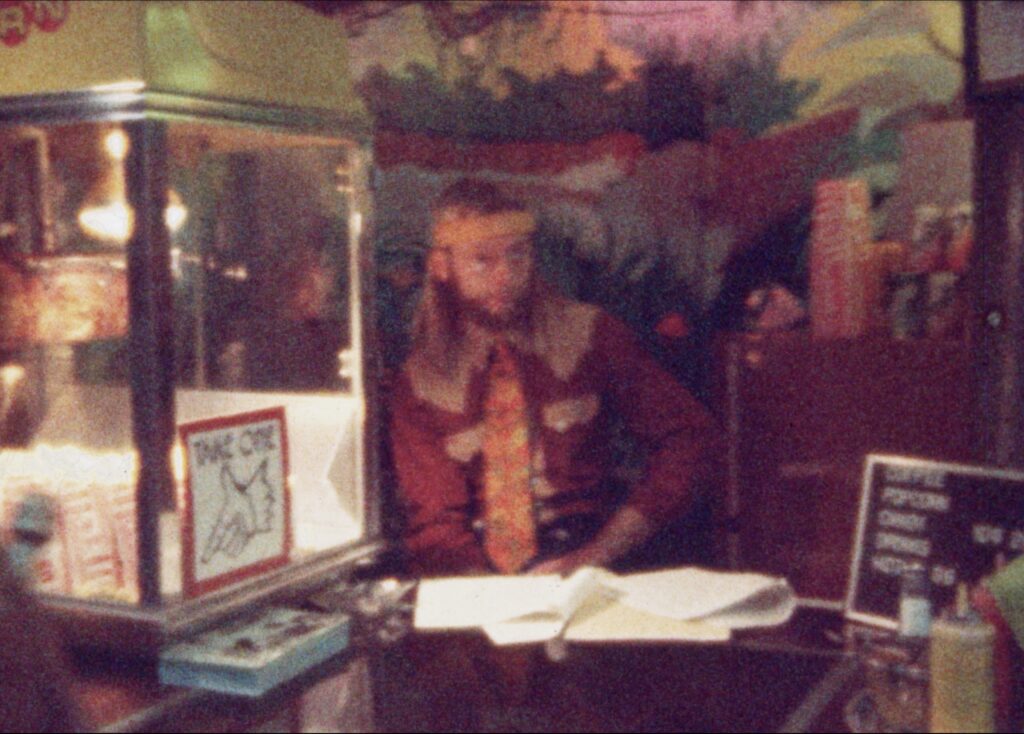
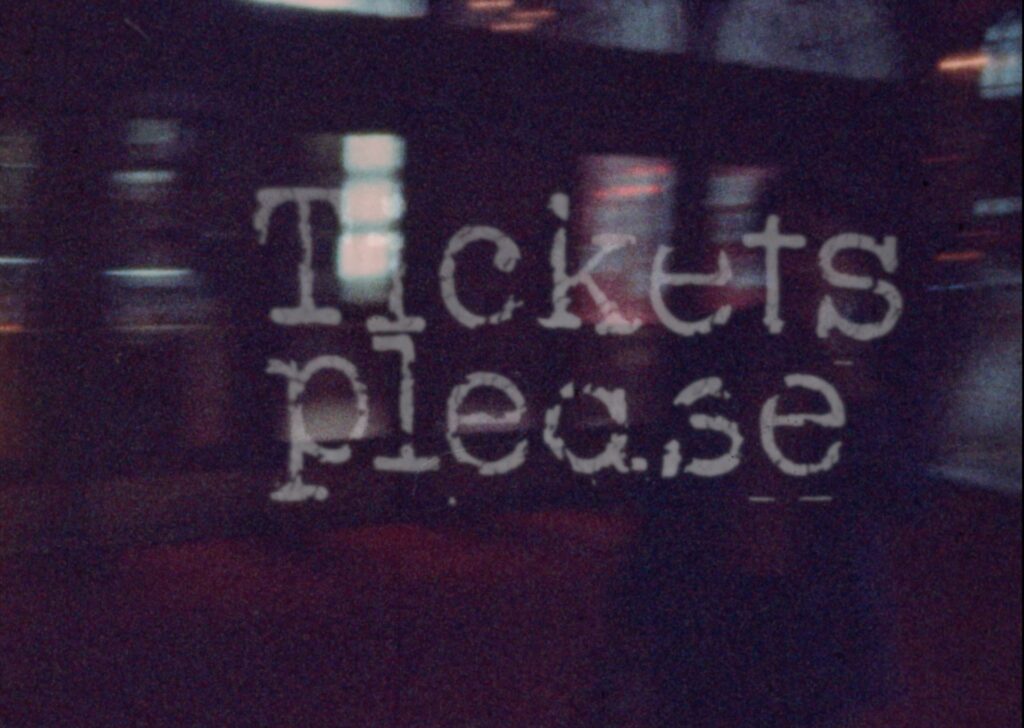


______________
Wild Gunman (1978)
‘Mobilizing wildly diverse found-footage fragments, obsessive optical printing, and a dense “musique concrete” soundtrack, a maniac montage of pop-cultural amusements, cowboy iconography, and advertising imagery is re-contextualized within the contemporary geopolitical crisis in a scathing critique of U.S. cultural and political imperialism.’ — Artists’ Television Access
‘In 1978, experimental director Craig Baldwin (b. 1952 in Oakland, California) made a 16mm film deconstructing the ideology of cowboy masculinity, cultural imperialism, and capitalism. His 20-minute video collage includes images and sounds culled from various sources, including commercial, TV series and news, films, cartoons, and video games such as Nintendo’s fmv arcade game Wild Gunman (1974), an electro-mechanical arcade game developed by Gunpei Yokoi consisting of a light gun connect to a 16mm projection screen …and Midway’s monochromatic 2D shooter Gun Fight (1975).’ — Game Scenes
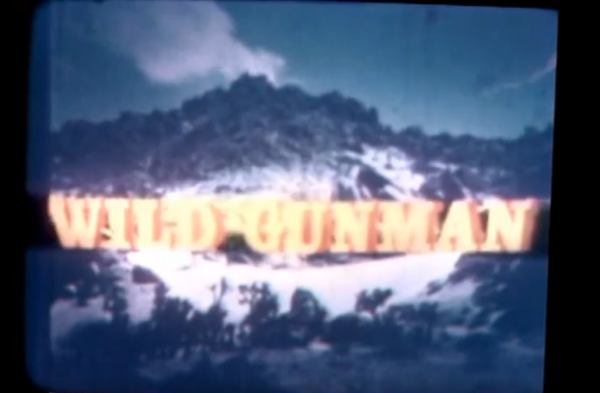
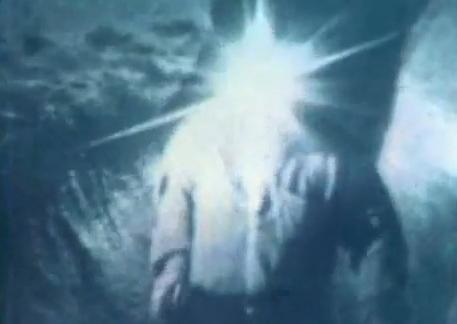
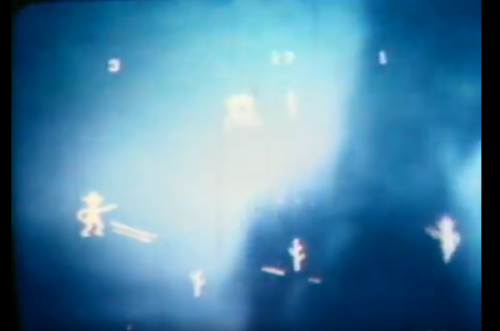
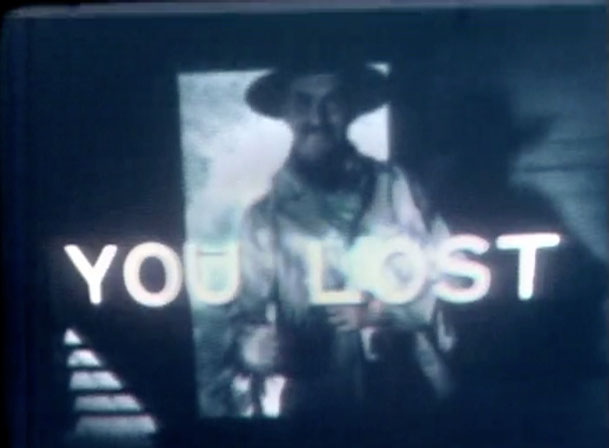
______________
RocketKitKongoKit (1986)
‘A fascinating info-dump about how the CIA and accompanying Western forces systematically fucked over the DRC’s chance of a progressive government over the 60s and 70s. Narratively devastating, laying out a timeline of shadow wars and colonialist meddling that sound like raging conspiracy theories when laid out, apart from the fact it’s all depressingly true. Formally, it’s taken a dint thanks to advances in explainer journalism and essay films, feeling a little junky at points when it cuts to soap operas and 50s Tarzan rip-offs. Its intentions are pure, which is weird to say about something so broken up about the world’s backroom evils.’ — illicit film club


_________________
Tribulation 99: Alien Anomalies Under America (1992)
‘In his 1991 film Tribulation 99: Alien Anomalies Under America, Craig Baldwin weaves together a riot of conspiracy theories to build the ultimate right-wing nightmare: an evil alliance of communists, aliens, and various non-white folks committed to destroying Norteamérica. By using stock footage, In Search of… b-roll, and creepy theremin sounds, Baldwin evokes a familiar and spooky world of ’70s paranormality, ’50s anti-communist loopiness, and ’80s reactionary politics. It is dizzying, fascinating, and sometimes hilarious as it critiques the US’ often absurd colonial depredations in Central and South America. In 48 minutes Baldwin manages to confuse, amuse, and inform without seeming arch or heavy-handed. By moving deftly, Tribulation 99: Alien Anomalies Under America avoids being smug while driving the point home relentlessly.’ — Pop Matters
Trailer
Excerpt
Excerpt
________________
¡O No Coronado! (1992)
‘The first two minutes of Coronado offer more historical perspective than both Columbus epics combined…Coronado, one of the least successful conquistadors, is perfectly suited to Baldwin’s purposes in part because his motivation is so blatantly delusional. Arriving in Mexico in 1538, he set out on a fruitless quest to find the imaginary Seven Cities of Cibola. Crossing the desert and the Rio Grande, Coronado explored what is now Arizona and New Mexico, stumbling across the Grand Canyon and engaging in numerous needless fights wit the Indians. The non-existent cities of gold led his expedition as far afield as present-day Kansas, before returning to Mexico City in sodden disarray. Baldwin illustrates this empty quest with a melange of images culled from swashbucklers and westerns, classroom movies and museum paintings. Christian cartoons and industrial documentaries. He uses whatever comes to hand. This pragmatism produces a richness of metaphor. A clip from an old Vincent Price film stands in for the Inquisition. Coronado is occasionally visualized as Gulliver; when his Indian guide leads hism astray, he’s the Lone Ranger, accompanied by Tonto (and, quite poetically, a few passages from Ravel’s Bolero. When necessary, the narrative is goosed along with a few costume dramatizations. (Coronado is played by a goofy-looking actor in a Spanish helmet). Everything is tied together with generic sci-fi music, strategic sound effects, and two narrators (one specializing in boastful rants), Baldwin is more honest (than regular historical documentaries) in representing the present, interviewing not scholars but tourists and locals: “Coronado: isn’t that a shopping mall around here?” If you want to schlockument the box populi, this is how.’ — J. Hoberman

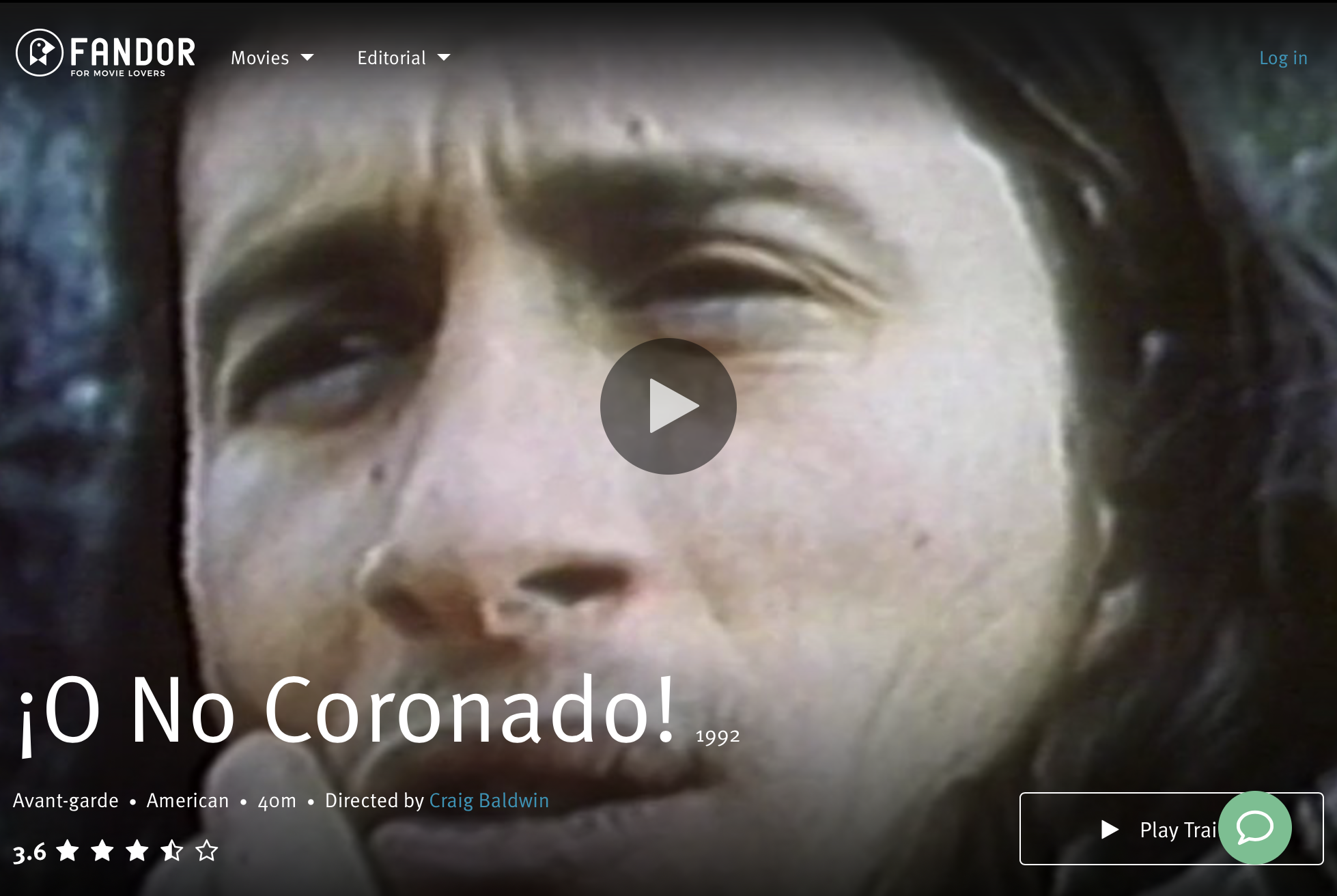
_______________
Sonic Outlaws (1995)
‘By their own reckoning, members of the Bay Area recording and performance group Negativland got themselves into trouble by having too much fun. Their prank began with a pirated audiotape of Casey Kasem, the normally boosterish-sounding disk jockey and radio personality, as he cursed a blue streak while trying to record a spot about the band U2. Sensing opportunity at hand, Negativland enthusiastically mixed these mutterings with samples from a U2 song, then put out a 1991 single on the SST label with a picture of the U-2 spy plane on its cover.
‘Sonic Outlaws, a fragmented, gleefully anarchic documentary by Craig Baldwin, approaches this incident from several directions. Some of the film is about the legal nightmare that ensued from Negativland’s little joke. In a highly publicized case, U2’s label, Island Records, charged Negativland with copyright and trademark infringement for appropriating the letter U and the number 2, even though U2 had in turn borrowed its name from the Central Intelligence Agency. SST then dropped Negativland, suppressed the record and demanded that the group pay legal fees. Trying to remain solvent, Negativland sent out a barrage of letters and legal documents that are now collected in “Fair Use”, an exhaustive, weirdly fascinating scrapbook about the case.
‘Sonic Outlaws covers some of the same territory while also expanding upon the ideas behind Negativland’s guerilla recording tactics. Guerilla is indeed the word, since these and other appropriation artists see themselves as engaged in real warfare, inundated by the commercial airwaves, infuriated by the propaganda content of much of what they hear and see, these artists strike back by rearranging contexts as irreverently as possible. Their technological capabilities are awesome enough to mean no sound or image is tamper-proof today.
‘Mr. Baldwin who expressed his own interest in culture-jamming and recontextualization through practices like altering billboards before making this documentary collage, explores the implications of this approach. These sonic outlaws specialize, according to one of them, in “capturing the corporate-controllec subjects of the one way media barrage, reorganizing them to be a comment upon themselves and spitting them back into the barrage for cultural consideration.” Those interviewed here, including members of Negativland, John Oswald and the Tape-Beatles, speak of such tactics as both cultural criticism and subversive fun. Sonic Outlaws does some recontextualization of its own by connecting such appropriation art to its antecedents: anything from Cubism or Dada to using Silly Putty to copy comic-book drawings. Using quick snippets and flashes that often emphasize the film maker’s taste for proudly tacky sci-fi movies of the 1950’s, Sonic Outlaws captures the wide range of effectiveness that such tactics can have. Sometimes the results are authentically witty and illustrate Mr. Baldwin’s ideas. But the ingenuity of toying with a Brylcreem commercial or putting words in the mouth of a video Ronald Reagan(“After all, I was the nightmare of America and the human race”) trivializes the thoughts being discussed.’ — Other Cinema
Trailer
Excerpt
DVD Extra
_______________
Spectres of the Spectrum (1999)
‘American film-maker Craig Baldwin is the Ancient Mariner of American underground cinema, button-holing the unwary with rambling, hair-raising narratives of doom and perdition. His stories, in which no less than the entire history of Western culture is at stake, are paranoid epics of warfare and psychological combat. Baldwin’s speciality is sampled cinema – he slowly, painstakingly builds mosaics of TV and film footage, sometimes only a couple of seconds long, and transforms them, with the addition of breathless voice-overs, into paranoid narratives of conspiracy and mind control.
‘Spectres of the Spectrum is only marginally less delirious than Baldwin’s Tribulation 99: Alien Anomalies Under America, a mock-reactionary sci-fi story that satirically presented Kissinger, Pinochet and the Contras as intrepid hunters of extra-terrestrial vampires. Where Tribulation 99 laid itself open to incomprehension by masquerading as a crypto-fascist rant, Spectres positions itself on the revolutionary margins of the near future. Its heroes, seen in live-action footage, are a young telepathic woman, Boo Boo, and her father Yogi, agit-prop broadcasters in the people’s Resistance to the New Electromagnetic Order.
‘The narrative key to all this is a 1950s popular science TV show, in which Boo Boo’s grandmother has concealed a message which will aid the future revolutionaries. As Boo Boo travels back in time to unlock granny’s secret, Yogi scans the history of the electro-magnetic power struggle, from Benjamin Franklin’s kite, through electrical pioneer Nikola Tesla, to the age of the internet and its “corporate colonisation of the imagination”. Disorienting as the film is, you can always trace a passionate conviction – the opposition to the ownership of images. Baldwin’s sampling style wrests found images away from copyright and any official meanings they may once have had. Innocuous moments of family entertainment yield worrying new meanings, dark warnings of a future world under the surveillance of “Disney spy satellites”.’ — Jonathan Romney
Trailer
Excerpt
Excerpt
________________
Mock Up on Mu (2008)
‘It’s 2019. From his Empire of Mu on the moon, L. Ron Hubbard dispatches sexy Agent C. to Earth on a secret mission of espionage and seduction … The giddy, scary Mock Up On Mu is the latest obsessive exercise in audio-visual overload and pop-culture collage from San Francisco underground legend Craig Baldwin, who perfected rapid-fire found-footage assemblage mashed with bizarro subterranean revisionist history in 1991’s amazing pseudo-doc sci-fi conspiracy opus Tribulations 99: Alien Anomalies Under America. (Baldwin’s also the director of 1995’s Sonic Outlaws, a documentary on copyright, fair use, and the culture jamming band Negativland). “From an undisclosed location and the teeming mind/editing suite of collage master Craig Baldwin emerges this masterfully subversive counter-history of contemporary California, i.e. the postmodern world. Intertwining biographical err… speculation, re-enactment, found footage and a light touch of smut, Mock Up on Mu bravely wades, scissors flying, into the interlocking lives and careers of Jack Parsons, founder of the Jet Propulsion Laboratory, Marjorie Cameron, pioneer of the New Age Movement, sci-fi hack/religious leader L. Ron Hubbard and notorious warlock Aleister Crowley. Alternately (and simultaneously!) disturbing, funny and just plain slap-your-forehead weird . . . Mock Up on Mu will send its dazzled, slightly befuddled viewers blinking into the bright sunlight of a subtly altered world . . . No one chops and cuts the viscera of our schizoid culture with quite the glee and gusto of Baldwin” (Peter Culley, Vancouver I.F.F.).’ — The Cinematheque
Trailer
Excerpt
___________
Bulletin (2015)
‘An exploded view of a ballistic issue. With Big Pharma and the NRA lurking just outside the frame, a mid-century media-archeological marvel unpacks the triangulated discourse of familial patriarchy.’ — Canyon Cinema
the entire film
*
p.s. Hey. ** Dominik, Hi!!! You are back, yoo-hoo! I’m happy you had such a good time, and that your dad occasioned smoothness. Cool. I don’t know Eva Beresin, but I’ll check her work out. I’m doing okay. My week was … nice enough, lowkey. The film remains stuck in hell, but Zac gets back from his vacation this week, I think, and then we’ll start trying to de-hell things. Choosing a favorite cake is extremely tough, but I think might just join you in picking the third from the last. Its charisma gets to me. Love seeing Brad Pitt walking down my street yesterday towards the skateboarding Olympics venue and giving me a curious look like … you look familiar, G. ** Jack Skelley, I hope Carrie saw your thanks from the ether of wherever she may be these days. That blog share of Karina Bush’s stuff would be most welcome, natch. As soon and as harshly as humanly possible re: Fuckhead, thanks. xo, Dennis the Juice. ** David Ehrenstein, A friend of mine is writing the Paul Thek biography. In fact I think he finished it. He says it’s going to be very fascinating. ** Gabriel Hart, Hi Gabriel. Thanks for writing, I wrote you back. I tend to eat around marzipan, but it is architecturally helpful. ** _Black_Acrylic, Thanks, pal. The space between football/soccer seasons always seems so brief. Good luck on Saturday. And, yes, those insane fascist far right people you have over there. Jesus Christ! ** Lucas, Hi. I know, I think my ear is going to have to bite the medical bullet, sadly. ‘Husbands’ should give a pretty good idea of whether his stuff has anything for you. I think the Olympics have a little less than a week to go. It’s kind of sad. But then there’s a couple of week break and the paraOlympics move in. I guess there’ll be a lot less people for that, people being boring and so perfection obsessed and all. God, so sorry about your parents. You already know that your dad is just scared of having to think differently than he’s used to thinking, but I guess that doesn’t help all that much. Obviously, don’t let his words impact you as best you can. Ignorance is not bliss. I guess enjoy the rest of the weekdays as best you can. xo. ** Nika Mavrody, Well, thank you. It’s hard to compete with Denny’s restaurant, but I do try. ** Måns BT, Welcome home! And a homey home even. I was going to say try high speed unwinding, but I think that’s an oxymoron. Most of the films of interest I’ve seen of late have been watched in the course of making blog posts, for instance a few Craig Baldwin films re: today and a couple of Philippe Garrel films re: an upcoming post I just restored. Wow. Well, Bresson is my artist god among all artist gods, so I heavily recommend him. My all time favorite film is his ‘The Devil, Probably’. I think every film of his is great except for the first couple when he hadn’t quite found this style yet, but my other particular favorites of his are ‘Mouchette’, ‘Lancelot du Lac’, ‘Four Nights of a Dreamer’, and … well, I’ll stop there. I only really like the early Cassavetes films — ‘Faces’, ‘Shadows’, ‘Husbands’ — but he’s awfully highly regarded in general, so it’ll be good for you to experience his work and see what you think. Yes, ‘Justine’ is good. It would be my third favorite. If you’re not on your way to the festival, I hope things are relaxed yet exciting. Well, I hope so even if you’re already on your way too. ** Harper, No prob, pal. The rural or rural-ish and mushrooms can be a good combination. Have you had the phone call yet? I hope it’s just standard good news. I guess the obvious thing is to try to find flatmates who are rarely there? Zac has a flatmate, but she’s only there two weekends a month, so he really lucked out. ** jay, I remember watching some horror movie where the killer was a wannabe cannibal and he killed some woman he thought was really pretty and presumably delicious, but when he cut her body open and saw all the intestines and stuff inside her, he was like, ‘Holy crap, yuck.’ That makes sense about the music thing. Thanks, I was curious. I’m kind of the opposite, I don’t find written porn titillating at all, but visual porn, yes, sometimes. Yikes, I hope your leg is muted again. Man, sorry, that’s, like, scary to imagine. ** Dev, Hi. I’m sure my disinterest in the olfactory when it comes to my body must be very revealing of something. I love clues and hints, and it’s interesting to think of myself as a receptacle of clues, so no problem. I disd type Terre d’Hermes into a note on my phone, so I will inhale a bit of it assuming it’s available here, and, since it’s Hermes, no doubt. I still constantly confuse Hermes and Hermé, or, rather, I always mean Hermé and people think I mean Hermes. You’re back in school, whoa! That snuck up. Do you get to choose what the mock-patient’s mock-problem is, or is that assigned? Do you have a dream mock-patient who you would love to give good or bad news to? I hope that goes swimmingly. ** Steve, You’re on a tear. I liked the short track. It packed its concise space ultra-well, I thought. ** nat, I would love to have found out in a number of those cases. Maybe it’s just me, but a cute boy with bunny ears suggests infinite possibilities. Okay, maybe not infinite. But a week’s worth certainly. I hope your book report gets an A+ in whatever form that high mark manifests. ** Okay. Today I give a day about the exciting and fun experimental filmmaker Craig Baldwin. There are treats up there if you in the mood to let them in. See you tomorrow.




 Now available in North America
Now available in North America 
Oh my god, that Aliens In America one is bringing memories back! I think I must’ve seen that when I was a kid, without the context. It’s interesting to present aliens allegorically as a left-leaning invading force, you normally see them as a sort of apolitical colonial force. I may have to rewatch that film actually, basically anything with aliens always really interests me. I do just kind of find the idea of disappearing/being abducted for a few hours and coming back entirely altered fascinating.
Haha, that does sound like a lot of people I know, that failed cannibal thing. I’m sure most people who believe themselves to be cannibals/necrophiles/etc are probably the same, inasmuch as they’re interested in abstract concepts of these things e.g. cold bodies, unresponsive partners, and not the actual reality, e.g. actual corpulence.
Yeah, that is sort of interesting about visual/nonvisual pornography, it seems to be one or the other for most people. I don’t think there’s anything to it really, it must just be some random quirk like eye colour.
Also, about the blood thing, it isn’t at all disturbing to me or anything, don’t worry. It happens every few days for me, it’s just something that sort of happens if you have a cannula, it’s not at all frightening to me anymore. I think there is a certain kind of quality to the blood I instantly recognise, so I personally don’t freak out, but if I’m in bed with someone and they touch me and it comes back bloody, they’re sort of unsurprisingly terrified. So I think for me, seeing my own blood is a little more of an awkward, shameful thing than actually scary. Like, as awkward as a stranger seeing your genitals or something. Anyway, thought you’d find that interesting! Enjoy your day!
Craig Baldwin is Bruce Conner on ACID.
.
Was Brad Pitt flirting with you Dennis? I’d love to think so.
Hi!!
To be fair, Eva Beresin’s paintings are a lot more impressive in person, but you’ll get the idea by searching for her work online.
A low-key week sounds really nice. Ugh, and I hope the de-helling will be successful or promising at the very, very least…
We can share that charismatic head cake, no problem!
Brad Pitt the actor or Brad Pitt the boxer? 😀
Love becoming a world-famous mukbanger, Od.
hi! good luck if you end up going to the doctor. the olympics don’t really feel like that much of a big deal anymore which is kind of sad even though I’ve never been a huge sports fan. I used to love watching ice skating but then it got really depressing after that doping scandal involving a 15 year old whose health and life were being ruined by the sport. did you go see skateboarding after all? I think you mentioned that a while ago. yeah, I’m just in a really shitty situation with my dad. one of my nicer family members called him to talk to him about it and apparently he’s not going to talk to me about it while I’m staying with him, that he wants me to be happy, that “it’s just hard for him,” etc. frankly I think it’s incredibly dishonest of him to play the role of confused old man because I’ve been out to him for more than a year now (I’m just coming out to other people now) and I’ve been very clear and he’s never had any issues correctly gendering any of my trans friends. for him it’s an issue of denying my agency and just refusing to accept that he can’t control that I live outside of the weird conservative, catholic framework he set for himself and his other children. I don’t really feel like arguing with him about it because I don’t see him magically changing his mind. I just feel so angry and I don’t know what to do. but I hope you’re doing well, ear trouble aside, and that you and zac can finally get ahead with the film this week.
Craig Baldwin is a new name for me, and Sonis Outlaws looks to be of especial interest. From the preview, his ideas seem very prescient indeed.
https://www.bing.com/videos/riverview/relatedvideo?q=Brad+Pitt+in+Thelma+and+Louise+video&mid=32F5E9F2E1D00866F07032F5E9F2E1D00866F070&FORM=VIRE
Brad Pitt Uber Alles
AHH ! spent half an hour typing up a very detailed comment, paraphrased now once lost:
((1)) Apologising for late reply on VR comment – impromptu friend over so didn’t get the chance- torrented double-feature of Snake in June (2002) and The Dreamers (2003) – ripping drunk on grape Soju – pulling books from shelves flipping through randomly and reading – tried to explain the kafka epigraph in White’s The Beautiful Room is Empty – asked friend to hand three random books – they picked Guide (yourself), 120 days and complete works of Rimbaud – you and Sade were the doors opening and Rimbaud was the quote unquote ‘Beautiful Room’ – characterised the night as ‘charged’.
((2)) Declaration that I am: Unlikely to ever wear VR headset.
((3)) Description of VR film I made in film school.
((4)) Detailing the shortcomings of Zuckerberg’s metaverse.
((5)) Anecdote about childhood brain condition which gave me violent bouts of vertigo and nystagmus – spend months in bed staring at ceiling, unable to move head without room spinning – puking.
((6)) description of the use of bovine VR headsets used to ensure happy cows and tasty meat – imagining the industrial headsets – drilled into cow-skull? comment on dogs experimented on during MKUltra
((7)) description of scene in Death in June – metal cone tied to man’s head – obscures vision bar the very end of the cone where he can see a small circle of a torture scene happening before him whilst he is chained to the floor.
((8)) description of two panels in comic book – found here (p1470): https://archive.org/details/invisiblesomnibu0000morr/page/1470/mode/2up
((9)) description of conceit in comic book – found here (p1467 to 1468): https://archive.org/details/invisiblesomnibu0000morr/page/1466/mode/2up
((10)) key17 drug being used to convert words into hallucinatory-reality generation into torture – show subject the word ‘wound’ and he’ll feel it (p140 to 141): https://archive.org/details/invisiblesomnibu0000morr/page/490/mode/2up
((11)) imagined SmartDrinks sent from the future with information encoded into liquid molecules.
((12)) love letter to the new orifice punctured onto Jude Law’s back in eXistenZ (1999) – virtual reality as new biology – penetrated by machines slick with motor oil – fitted with BioPort – toes stroking Umbicords – throbbing fleshy GamePods.
((13)) word by word typed out section of Preciado’s essay ‘after the book, let’s print on flesh’ – fabulously put by him – paraphrased here as [comparison between the secularisation of the word following Guttenberg bible, and the secularisation of the flesh following imagined neo-genitals made from 3D printed flesh] – can’t do it justice but can’t be arsed typing it out again right now.
Hope this sends this time…
I feel Four nights of a dreamer and A gentle woman are the most hidden gem films of Bresson. Might be a me thing though just in my mind. I like these films so much but I love all of his filmography. Les Dames du Bois de Boulogne is so good too I think it’s his first banger. Did you ever think that actress Chloe Sevigny looks a lot like Maria Casares? If you think about it a little you will see it I wonder if someone told her before but I am sure she is aware
Hi from Crete to Paris just when I finished this post Destroy everything you touch by Ladytron came on shuffle and thought that you like it
Ooh, that Wild Gunman thing looks particularly interesting. Another artist for my to-watch list, thank you!
Yeah, there weren’t really any floats at Vancouver Pride. There were vans and buses that had been decorated (at the tail end of the parade, there was a beautifully-decorated bus covered in UFOs and other things, representing the Animator’s Guild, which was rad!), but nothing bigger than that. From talking with friends who’ve lived here longer, the old route used to allow for floats and such, but the new route is too narrow or something. Feels like a cop-out to me.
I can relate to wanting trashy soft ice cream. Luckily here there’s no shortage of good OR bad ice cream. I do miss the kind of cheap junkfood I could get back in the UK though. Actually edible but also pretty cheap. Here in North America the gulf between inedible budget Walmart slop and “pretty good” is a much bigger expense. My kingdom for a Greggs in western Canada!
Today has been melancholy. I have a lot of friends in the furry community, and the guy who ran one of the biggest art gallery sites for the fandom died suddenly last night. Sounds like he was a victim of US health insurance cruelty. There’s a lot of sadness and anger there, and fear that these galleries might be lost, and with them a huge amount of artwork and stories from two decades of the fandom. The idea of archives being lost makes me very worried, and subcultural archives doubly so. I’m sure you can relate, given the shit that happened with your blog some years back…
Thank you for the opening paragraph of today’s post. Words, words, words. As always. Very important. As is Craig Baldwin! The Reagan bit (in Outlaws I think?) was hilarious.
Had my blood taken for some test yesterday and was very tempted to ask for a vial. Would’ve tried if I were any good as a painter. Hmmm re: the olfactory disinterest in your body. Would’ve always imagined you wearing something woody but the no perfume thing is, as Dev noted, interesting in its own right. Have you written any non fiction (what an arbitrary grouping) recently?
I imagine the term “underground” derives from Dostoevsky’s novella (1864); Zola was the first to draw the Scientific Method into a literary context with the “experimental novel” (1880). My understanding of avant-garde is that it post-dates the other two, and should be historicized with modernism in Russia — which is why it seems to often be mistaken for a ‘vanguard.’ Cool lede GIF.
Do you know why Baldwin stopped making films? They were so cheap that I wouldn’t think money would be an issue. How is his book?
I had a 2-hour long Skype chat with a friend last night. He finished a film last year, and he’s now in the process of sending it around to festivals. He’s wondering if he should keep spending money on that process or start saving up towards his next film, because the festival submission fees are coming close to rivaling his budget.
Thanks re: my song. I wanted to complete it as quickly as possible, even if the results are imperfect. The minute-long length was inspired by the rapper DORIS, who performs fragmentary songs with pitched-up vocals over murky samples.
For Gay City News, I interviewed GOOD ONE director India Donaldson: https://gaycitynews.com/india-donaldson-feature-debut-good-one/
Hi Dennis!
Days behind here due to… a variety of nonsense, including the hurricane / tropical storm (it keeps changing its title by going into the ocean and coming back) that is just kind of loitering above our heads. I’m catching up on things while the power and internet still work. Tomorrow everything will be flooded around here, and I don’t expect things such as electricity will work. If the streets flood too hard, I do have a kayak (when I’m not writing or doing bullshit, i.e jobs, kayaking is a thing I love to do whenever possible – it helps clear my brain and is therefore an extension of writing) so I’ll be able to paddle out of here if nature requires. Won’t be able to get very far but… it’s an option everything goes under water.
Finally done editing the book with Schism! (six months ago, when Gary found me, I claimed I’d be able to do it in 2 weeks… this was woefully inaccurate by the better part of a year). We’re looking at a release of late September. So that makes me breathe a little lighter.
Carrie’s post was fantastic. In the grand scheme, I’m not too far from WV. Even though it was noted as a very old post, I took a look to see if I could find that she’d opened a shop so I could get a macabre cake for any upcoming special occasions. I didn’t find anything but if you get any intel do let me know!
Hey. Yeah, I had the phone call and everything is fine. They were treating me like a medical marvel! They were nice about it, just a bit surprised. They told me not to worry. With my hormone levels they were surprised that I had even gone through puberty! I’m still going to have to wait a week while the woman I was speaking to talks with her supervisor but she told me it was just to make sure. It’s not a question of me not getting my prescription so I can relax on that front.
Yep, the ideal scenario is having flatmates who are out a lot. I’ve lived with friends in the past and it’s difficult to get things done when everyone else wants to sit around and smoke weed all day. And since I don’t like weed, it’s so boring to be around a load of high people saying the same sentence over and over again and laughing uncontrollably when you’re not high yourself. My social life would probably be better if weed didn’t make me insane.
I’m halfway through ‘Out 1’, Jeanne-Pierre Leaud has said his first sentence. I feel like I can see kind of what’s happening now, and I’m hooked. It has a novelistic scope in how it doesn’t feel the need to tell you what it’s doing and you have these raw long takes that are confusing at first but unravel as they go on, and slowly you feel like it’s all starting to make sense. I’m always amused by the idea of Leaud in this movie, walking around all day like a maniac while trying to solve secret plots inspired by Balzac novels. When I finish this I’m going straight to ‘Celine and Julie…’.
Good to see this day celebrating our local legend. And it was great revisiting the cakes yesterday. I do have a weakness for pastry, it’s a constant battle with my waistline.
I saw Longlegs. Pretty enjoyable, but I thought it was trying to do too much.
I have my copy of Flunker, finally. Yesssss.
Bill
Similarly to the gorilla story, I recently got my cat one of those sets of buzzers with, like, little icons for food and cuddles and stuff like that so they can sort of communicate — problem is, it came with a standard keyboard and he just keeps typing “Hey, Dennis!” over and over and over. I’m not sure what he wants. I won’t euthanise him, but, man, I wish he’d stop trying to break into the bin.
Super cool about ‘LAST SPRING: A Prequel’! I love robot stuff. Completely different sort of robot, but I probably still think about the ‘Can’t Help Myself’ robot at least once a week — which might be too much. Also, the ‘Baked’ post the other day made me consider my fondness of meat. Sheesh. Craig Baldwin went down much easier with my morning coffee.
Sending good vibes from over here, where our weekend high is expected to be a whole 22 degrees!